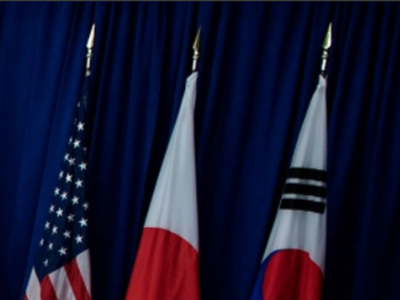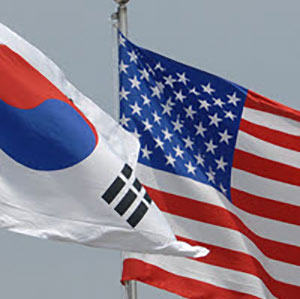Emerging Threats and U.S.-ROK-Japan Security Cooperation in Northeast Asia
Soyoung Kwon identifies North Korea’s nuclear weapons programs and China’s power and influence as top concerns for both South Korea and Japan and argues that the U.S. alliances with South Korea and Japan are more critical than ever in countering these evolving threats.
The military alliance between the United States and the Republic of Korea (ROK) and the trilateral U.S.-ROK-Japan security partnership have been cornerstones of stability and security in Northeast Asia, particularly in the face of North Korean provocations and the rise of China. A Pew Research Center survey on threat perceptions in East Asia reveals that North Korea’s nuclear weapons programs, followed by China’s power and influence, are top concerns for both South Korea and Japan. In both countries, there has been a significant rise in the perception of Russia as a threat, driven by its deepening ties with North Korea. While Russia is still viewed as a lesser concern than China, the growing alarm over Russia’s influence underscores its increasing role in regional instability. In this context, the U.S. alliances with South Korea and Japan are more critical than ever in countering these evolving threats.
The U.S.-ROK Alliance and U.S.-ROK-Japan Trilateral Security Partnership
The U.S.-ROK alliance reinforces military deterrence and readiness through continued joint exercises and the deployment of strategic U.S. military assets. The joint military exercises between the United States and South Korea, including Freedom Shield, the Hoguk field training exercise, and Vigilant Storm joint air training, prepare the two nations to respond effectively to provocations. The regular deployment of strategic U.S. military assets, including nuclear-capable bombers, aircraft carriers, and attack submarines, showcases the United States’ commitment to mutual defense and deterrence against potential adversaries. The Nuclear Consultative Group (NCG), established in 2023, provides a forum to address the persistent and evolving nuclear threats posed by North Korea through facilitating dialogue, planning, and coordination between the U.S. and ROK administrations on the potential use of strategic and tactical nuclear weapons.
The U.S.-ROK-Japan trilateral security partnership commits the three nations to an institutionalized collaborative framework forged at the August 2023 summit, where they agreed on close consultations and collaboration on military affairs. This includes enhancing the tempo and sophistication of their joint military exercises and sharing sensitive missile-warning data on North Korea in real time. The Trilateral Secretariat was established in 2024 with the objective of making the Indo-Pacific region prosperous, connected, resilient, stable, and secure. The trilateral partnership can serve to optimize strategic resources, enhance military deterrence, present a unified front against geopolitical rivals, and foster close political and diplomatic coordination.
Potential Challenges
The future of these partnerships, however, faces significant challenges. The unpredictability and uncertainties stemming from South Korea’s domestic political crises, the return of the Trump administration, and the volatile security environment in Northeast Asia all heighten concerns about the long-term stability of both U.S. alliances and the trilateral partnership. Research on the durability of alliances highlights key factors such as a shared perception of common threats, hegemonic leadership, credibility and reliability, supportive domestic politics, high levels of institutionalization, and ideological similarities. Alliances are more likely to endure when states have confidence that their allies will honor their commitments, particularly in terms of mutual defense and broader alliance goals. This includes the ideological affinity and shared values that form the foundation for cooperation and solidarity. A key challenge for the U.S.-ROK alliance and the U.S.-ROK-Japan security partnership is the extent to which these countries can trust each other’s commitments and align their goals based on a shared perception of threats and ideological affinity.
The political void in the ROK. South Korea is undergoing a severe political crisis triggered by President Yoon Suk Yeol’s declaration of martial law on December 3 and subsequent impeachment. This political turmoil undermines the Yoon administration’s Indo-Pacific strategy released in 2022, thus challenging the prospects for the U.S.-ROK alliance and cooperation with like-minded countries to effectively address the common threats to the liberal international order. In the midst of U.S.-China rivalry, the Yoon administration had strengthened ties with democratic allies in the region, engaging in joint military exercises, strategic dialogues, and economic policies aimed at countering Russia and China. However, a potential change in administration could alter South Korea’s foreign policy. A new administration led by the Democratic Party might prioritize engagement with China while reducing emphasis on relations with Japan, potentially straining the U.S.-ROK-Japan partnership. This shift in focus could also reignite rhetoric on historical grievances stemming from Japan’s colonial rule, further straining relations with Tokyo and rekindling debates over joint exercises or defense procurement strategies.
The ongoing political crisis has led to the postponement and cancellation of key visits and military engagements, undermining the trust needed for effective trilateral cooperation. The suspension of joint military exercises and deferral of critical engagements, such as the NCG, diminishes the operational readiness of the trilateral defense forces, which could hinder joint efforts to address North Korea’s security threats and other strategic issues.
Trump administration 2.0. Another key challenge is the uncertainty surrounding the United States’ commitment to the region during the second Trump administration. Trump’s first term was marked by a transactional foreign policy, skepticism of multilateralism, and demands for greater burden-sharing from allies, including the ROK and Japan. If these tendencies resurface, they could strain the alliances, particularly regarding issues like defense cost-sharing, the withdrawal of U.S. troops from the Korean Peninsula, and North Korea’s nuclear threat. Trump’s approach to renegotiating defense agreements to increase financial demands and his critical stance on initiatives like the NCG could lead to domestic backlash and potentially weaken the cohesion of the alliance.
Additionally, Trump’s preference for personal diplomacy and his close ties with authoritarian leaders like Vladimir Putin and Kim Jong-un could create discord between the United States and its democratic allies, complicating regional security efforts. His willingness to engage directly with North Korea and Russia, without a clear strategy for denuclearization, might weaken the collective stance on North Korean threats and regional cooperation. If the United States prioritizes deals with North Korea over its alliances, the ROK could reconsider its defense strategies, including by seeking independent nuclear capabilities, which would disrupt the existing balance of power in Northeast Asia.
The volatile security environment in Northeast Asia. Russia’s strengthened relationship with North Korea, formalized in the 2024 North Korea–Russia Treaty on Comprehensive Strategic Partnership, introduces a new strategic challenge. This treaty marks a significant upgrade in bilateral relations, including North Korea’s military support for Russia’s war efforts in Ukraine and Russia’s engaged economic and technical support for advancing North Korea’s nuclear and missile programs. Their closer alignment could counter the United States and its allies in the Indo-Pacific and exacerbate tensions in Northeast Asia.
While formal trilateral cooperation among China, North Korea, and Russia has not yet materialized, the trend toward deeper bilateral alignment suggests that the three countries could move toward a more comprehensive trilateral partnership in the future. Such a partnership would constitute a unified front opposing U.S.-led initiatives and significantly challenging the regional security architecture and efforts to resolve disputes diplomatically. This increasingly unpredictable security landscape demands a coordinated response from the United States, South Korea, and Japan to deter aggression and strengthen resilience, ensuring a stable balance of power in the region.
South Korea’s internal political turmoil is not disconnected from this regional security tension. The initial impeachment motion against President Yoon cited his “value diplomacy” approach and accused him of “neglecting geopolitical balance, antagonizing North Korea, China, and Russia, adhering to a bizarre Japan-centered foreign policy, and appointing pro-Japan individuals to key government positions, thereby causing isolation in Northeast Asia and triggering a crisis of war, abandoning his duty to protect national security and the people.” This provision triggered diplomatic scrutiny as U.S. officials questioned why stronger trilateral ties and improved relations with Japan were cited as grounds for impeachment. The U.S. ambassador to Seoul even canceled a scheduled meeting with the leader of the opposition Democratic Party of Korea. The clause was later removed in a revised impeachment motion, which triggered a parallel reaction from Beijing. China wondered whether external pressure, particularly from the United States, had influenced the removal of the “value diplomacy” clause.
This controversy signals potential vulnerabilities in the ROK’s foreign policy and its alignment with U.S. objectives. Therefore, it is critical for the United States to reassure the ROK of its unwavering commitment to security and support political stability in Seoul to preserve the strength of the alliance.
The Way Forward
To address ongoing political instability in the ROK and the deteriorating U.S.-ROK-Japan security relationship, the U.S. Congress will need to advocate for diplomatic engagement, reaffirm military commitments, and enhance regional coordination. Facing escalating threats in Northeast Asia, it must reaffirm the U.S. commitment to defending the ROK and Japan by increasing security assistance in missile defense, cybersecurity, and antisubmarine warfare. Congress should also re-evaluate defense burden-sharing agreements and broader cooperation mechanisms by initiating discussions with the Department of Defense and the ROK, ensuring equitable contributions, and linking defense cooperation—including arms sales and joint training programs—to political stability in Seoul. Finally, a formal review of the U.S. defense posture would ensure that military assets remain aligned with the evolving security environment and domestic political dynamics in the ROK.
To counter the growing threat from the alliance between Russia and North Korea, the U.S. Congress could support enhancing trilateral security mechanisms between the United States, the ROK, and Japan. This includes strengthening joint military exercises, intelligence-sharing agreements, and missile defense systems. Congress could also facilitate high-level trilateral meetings to address the threat from North Korea’s nuclear program, as well as the broader regional security landscape, including Chinese assertiveness and Russian activities.
For the strategic interest of the United States in Northeast Asia, it is imperative to prioritize value diplomacy over transactional approaches. This is essential for countering the increasing threats posed by North Korea, China, and Russia, while fostering a unified front based on shared democratic values and respect for international norms. As regional security dynamics evolve, maintaining cohesion within the U.S.-ROK-Japan partnership requires a strong foundation of common values and goals, particularly through a commitment to an inclusive, stable, rules-based international order.
Soyoung Kwon is Professor of Global Affairs at George Mason University Korea.



